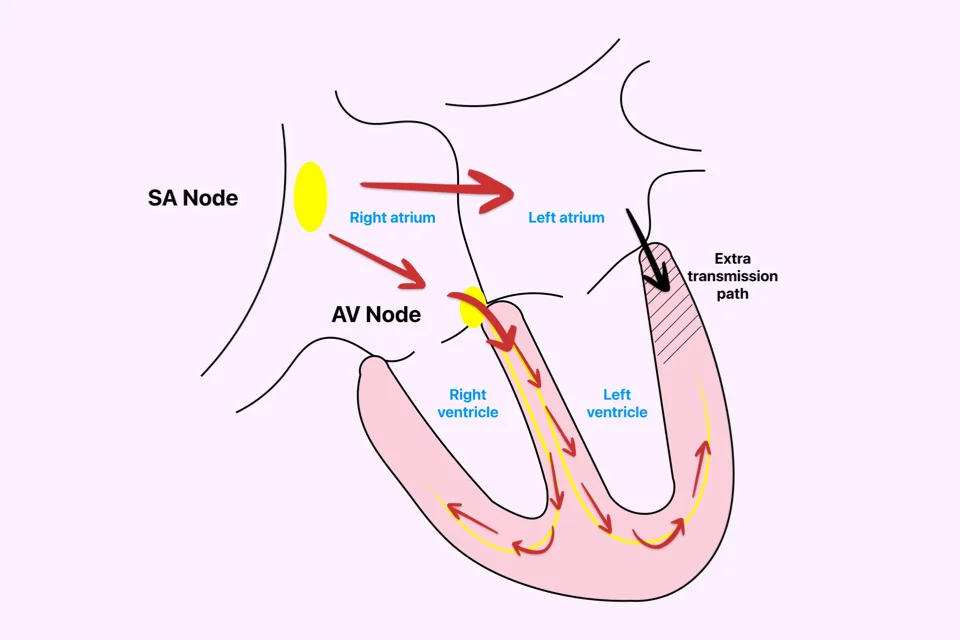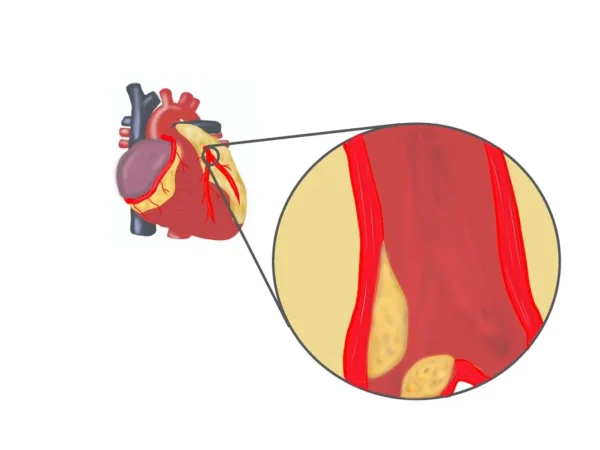Wolff-Parkinson-White (WPW) syndrome is a condition in which the heart has an extra electrical connection present from birth. This additional pathway allows electrical signals to travel between the upper and lower chambers of the heart in an abnormal way, sometimes triggering episodes of very rapid heartbeat.
Many people with WPW feel completely well most of the time. Others experience sudden attacks of palpitations that can be frightening, especially when they occur without warning. The important point is that WPW is not caused by heart damage or lifestyle factors—it is a wiring variation that some people are born with.
How WPW Affects the Heart
In a normal heart, electrical signals follow a single controlled route from the atria to the ventricles. This ensures that each heartbeat occurs in a coordinated sequence.
In WPW, an extra electrical pathway bypasses part of this normal route. Under certain conditions, signals can circulate rapidly through this shortcut, creating a fast rhythm. When this happens, the heart rate can suddenly jump to very high levels and remain fast until the circuit is interrupted.
This mechanism explains why WPW-related episodes often start and stop abruptly.
Symptoms of WPW Syndrome
Symptoms vary widely. Some individuals never experience noticeable problems and discover WPW incidentally during an ECG performed for another reason. Others have clear and recurrent episodes.
Before listing symptoms, it is important to emphasize that symptom intensity does not always reflect risk. Mild episodes can still require evaluation.
Common symptoms include:
- Sudden onset of rapid heartbeat
- Strong or pounding palpitations
- Shortness of breath during episodes
- Dizziness or lightheadedness
- Chest discomfort
- Fatigue after the episode ends
In rare cases, fainting can occur, particularly during very fast rhythms.
WPW and Supraventricular Tachycardia
WPW is closely related to certain forms of supraventricular tachycardia. The extra pathway allows electrical signals to loop between the atria and ventricles, creating a fast and organized rhythm known as atrioventricular reentrant tachycardia.
These episodes are usually not life-threatening, but they can be disruptive and recur unpredictably. Understanding this link helps explain why WPW is often discussed alongside SVT.
Why WPW Is Taken Seriously
Most people with WPW live normal lives without complications. However, in a small number of individuals, the extra pathway can conduct electrical signals extremely rapidly. If certain irregular atrial rhythms occur, this rapid conduction can lead to dangerously fast ventricular rates.
Because of this potential—though uncommon—risk, WPW is evaluated more carefully than many other benign rhythm conditions.
How WPW Is Diagnosed
WPW is often identified on an electrocardiogram. Even when a person feels well, the ECG may show characteristic features that indicate the presence of an extra pathway.
If symptoms are present or the diagnosis is uncertain, additional heart rhythm monitoring or specialized electrical testing may be recommended. These evaluations help determine how the pathway behaves and whether it poses any risk.
Treatment Options for WPW Syndrome
Not everyone with WPW requires treatment. Management depends on symptoms, pathway characteristics, and individual risk assessment.
Some people benefit from medications that reduce the likelihood of rapid rhythms. These drugs aim to control episodes rather than eliminate the pathway itself.
For individuals with frequent symptoms or higher-risk features, catheter ablation is often recommended. During this procedure, thin catheters are guided to the heart, the extra pathway is precisely located, and controlled energy is used to eliminate it. Once the pathway is removed, WPW is effectively cured, and normal electrical conduction is restored.
Catheter ablation is widely regarded as a definitive treatment for WPW. In experienced centers, success rates exceed 95%, and most patients are effectively cured.
Living With WPW Syndrome
A diagnosis of WPW can be unsettling, especially when discovered unexpectedly. With proper evaluation and individualized care, most people can remain active and unrestricted.
Education plays a key role. Knowing what WPW is, how episodes feel, and when to seek medical attention helps reduce anxiety and improves confidence in daily life.
In Summary
Wolff-Parkinson-White syndrome is a condition caused by an extra electrical pathway in the heart. While many individuals remain asymptomatic, others experience sudden episodes of rapid heartbeat. Careful evaluation allows clinicians to distinguish low-risk cases from those that may benefit from definitive treatment. With modern therapies, including catheter ablation, long-term outcomes are excellent.
Reference: WPW Syndrome






